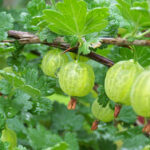“Gooseberries,” by Anton Chekhov is a highly symbolical short story that paints an accurate portrait of the Russian culture in the 1890’s. Though upon the first reading it may seem dull and uneventful, “Gooseberries” is a story that talks about many deep issues, such as what the ideal life would be and how to live it. Chekhov’s views on both of these issues are cleverly weaved into the story, as are the views of other schools of thought that were prominent at the time. Both the common mindset and the social tensions of the late 1800’s played a large role in formation of the characters in “Gooseberries,” as well as on the themes and setting which are enhanced further through the use of a frame story.
The characters weaved into “Gooseberries” were made just as much by the real life classes of Russia as they were by Chekhov’s imagination. It is therefore necessary to understand the culture and historical situation in which Chekhov wrote the story, as well as how it influenced him. The story itself was written in the early 1890’s, a time when social tensions in Russia were on the rise and about to turn into a full fledged revolution. Most people were poor peasants, and a small minority of the population owned a majority of the land. It is within this situation that Nicholai Ivanich’s desire to own a plot of land exists. Owning land was a symbol of wealth, and thus an easy pass into the country club of the rich. In addition land led to power, as seen by how Nicholai “was already at law with the village commune and both factories” (Chekhov 5) next to him once he had bought his farm. However, conditions were improving for most people as they started to gain more rights at the expense of the wealthy landowners like Nicholai. The fact still remained though that the czars of the time were slow to act on the peasants needs, being more caught up in their court life and luxuries. This lack of action and clinging to the status quo was also representative of the upper class and middle classes mindset. The common philosophy of the wealthy at the time makes its way into “Gooseberries” through the character of Nicholai, who himself serves as “a representative of the Russian middle class who, having been cushioned from discomfort for centuries, do not have the capacity to understand why society should change” (Piano 169). Nicholai’s personal views on the status of the peasants further illustrate his satisfaction with the system at the time. As he states to Ivan, “Education is essential, but for the peasants it is premature” (Chekhov 5). The fact that education was one of the few things that allowed the lower class to climb the social ladder, combined with Nicholai’s wish to deny them that opportunity, firmly establishes Nicholai as a lover of the status quo. However, Nicholai is not the only character of this philosophy in the story. As different as they may seem from Nicholai, Aliokhin and Bourkin are in fact quite similar to Nicholai in their mindsets. Throughout Ivan’s story and moral plea, they are “lulled by the atmosphere of the room with its frames of elegant people and the beautiful chambermaid” (Piano 168). Just as with Nicholai, their lives of comfort and luxury have rendered them unwilling to believe or do something about the suffering around them. Thus the characters of “Gooseberries” and their political as well as social philosophies were not simply products of Chekhov’s imagination, but also of his time.
However, Chekhov was not simply acting as a historian and recording common thought of his time period when he wrote this short story. Many of his reactions to common beliefs and his own personal views on certain philosophical issues are presented in “Gooseberries” as themes. For example, one of the prominent philosophers of Chekhov’s time was Leo Tolstoy, who firmly believed that the ideal life was a simple life lived in the country- a life of self-sufficiency. Tolstoy is famously known to have said that all a man needed in life was six feet of land. However Chekhov vigorously disagreed with this. According to Chekhov the ideal life was one in which all the talents and capabilities of a person are shown and reached. He felt that this kind of a life would have to take place in a city environment, where all kinds of people are present and there are plenty of opportunities. This belief becomes one of the major themes of “Gooseberries”; the theme that a country life would only lead to moral decadence while a life in the city could be filled with good work. Never is this theme more obvious than when Ivan himself states in the story, “It’s the correct thing to say that a man needs no more than six feet of earth.But six feet is what a corpse needs, not a man” (Chekhov 3). Clearly Chekhov is, through the themes of “Gooseberries,” debating Tolstoy’s beliefs, for the “correct thing” (Chekhov 3) that Ivan speaks of in “Gooseberries” is the exact same statement that Tolstoy made famous in real life. However, Chekhov does not settle with just an attack on Tolstoy’s arguments. He goes on, through Ivan, to state that, “A man does not need six feet of earth or a farm, but the whole globe, all nature, where he can have room to display all the qualities and peculiarities of his free spirit” (Chekhov 3), thus cementing his view that the city life, where there are many more opportunities for a man to express himself, was much more ideal than a country life. Off of this belief, Chekhov builds many other themes in “Gooseberries.” A prime example is the theme that happiness is nothing but an illusion when it comes as a result of “self-deception and hypocrisy” (Gullason 2). Just as Ivan introduced the previous theme into the story, Nicholai serves as the perfect victim of happiness through “self-deception” throughout “Gooseberries.” He goes from being hard-working and determined to being so lazy and fat that when Ivan finally meet Nicholai he “looked as though he might begin grunting into the quilt at any moment” (Chekhov 5). Yet despite this unfavorable transformation, Nicholai thoroughly convinces himself that all has changed for the better. As one critic puts it, Nicholai “is ecstatic in his failure” (Schorer 136). The best symbol for Nicholai’s self made illusion of happiness is his love for gooseberries. The gooseberries, just like Nicholai’s life, are “hard and sour” (Gullason 2), but to Nicholai they are sweet and delectable. Just as he has deceived himself into thinking that the “hard and sour” gooseberries taste good, Nicholai also makes himself think that his life, which is in actuality a failure, is perfect. In other words, “to Nikolay his illusions are not illusions-they are happy realities” (Guallason 2). Thus, Nicholai serves as the perfect example of the theme that happiness, derived from “self-deception,” is only an illusion.
One of the major tools Chekhov uses to bring this theme forward, as well as many others, is a cleverly worked frame story. By placing Ivan’s narrative within the overall story, Chekhov makes certain links between characters in the “framed” (Schorer 136) anecdote and the outside story more obvious than they normally would be. Two good examples of this are Nicholai and Aliokhin. At first glance they seem wildly different; Nicholai is fat and lazy while Aliokhin is a hard-working farmer, as evidenced by how dirty he is before his bath. Because of this difference in character, if Chekhov had placed Aliokhin and Nicholai in the same story and setting, it would be hard to determine any real kind of relationship between the two. However, by placing Nicholai in the “framed anecdote” and Aliokhin in the “surrounding action” (Schorer 136) Chekhov made it possible to create for each of them a situation, based on their character, towards which both of them end up developing similar mindsets. Since Aliokhin is a hard worker and likes physical activity Chekhov places him in the city. Since Nicholai is lazy and would rather have someone do the work for him, Chekhov places Nicholai in the country and gives him many serfs. And the result is that both of them develop the same political philosophies, despite the varying settings. Both become highly conservative and satisfied with the status quo- for Nicholai this translates to not educating the serfs more than is necessary for them to do their job, and for Aliokhin it simply means being satisfied with the luxuries surrounding him and not striving for a greater spiritual meaning in life. However, had Nicholai and Aliokhin been placed in the same story and setting both would have developed in radically different ways and it would be impossible to discern any real relationship between the two. But the frame story doesn’t just work to link characters. It also serves to create contrast between two different settings. The best case of this is Aliokhin’s house which is described as “a big two-storeyed house” (Chekhov 2). The upper story of the house is the setting in which Ivan’s anecdote is relayed, and downstairs is where Ivan, Bourkin, and Aliokhin joyously wash themselves. Thus, the upper story becomes a symbol of moral learning, while the downstairs becomes representative of “emotional release and physical pleasure” (Schorer 136), creating a large contrast since both of them still exist within the same house.
One of the reasons that “Gooseberries” has drawn such a large audience over time is because of its complexity and universal themes. At first glance the story is no masterpiece- it doesn’t even have a full ending. But upon further examination, “Gooseberries” proves very well structured frame story with themes and characters influenced highly by the Chekhov’s life and times. Because of the accuracy with which Chekhov presents his personal views and the sophistication of the story’s structure, “Gooseberries” will always be remembered as a classic.
Sources:
The Story: A Critical Anthology, edited by Mark Schorer, Prentice-Hall, Inc., 1950, pp. 61-5
http://www.answers.com/topic/gooseberries-story-7
The Short Story: An Underrated Art,” in Studies in Short Fiction, Vol. II, No. 1, Fall, 1964, pp. 13-31.
http://www.classicreader.com/book/1598/1/


